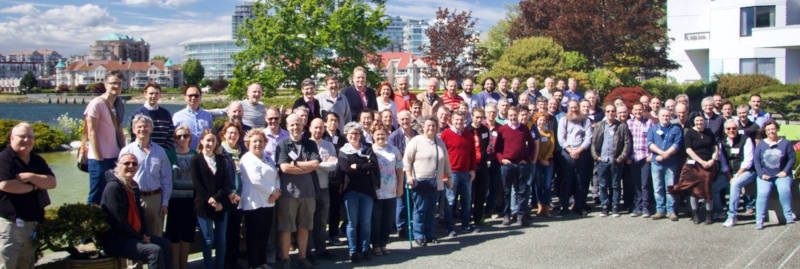
You won't see something like this (the May 2018 Interop group photo) in Spring 2020: The Sidney Interop, planned for early May, is going to take place using remote tools. Some of which I'd rather do without.
The Corona pandemic, regrettably, has also brought with it a dramatic move to closed, proprietary communication and collaboration platforms: I'm being bombarded by requests to join Zoom meetings, edit Google docs, chat on Slack, “stream” something on any of Youtube, Facebook, Instagram, or Sauron (I've made one of these up).
Mind you, that's within the Virtual Observatory. Call me pig-headed, but I feel that's a disgrace when we're out to establish Free and open standards (for good reasons). To pick a particularly sad case, Slack right now is my pet peeve because they first had an interface to IRC (which has been doing what they do since the late 80ies, though perhaps not as prettily in a web browser) and then cut it when they had sufficient lock-in. Of course, remembering how Google first had XMPP (that's the interoperable standard for instant messaging) in Google talk and then cut that, too... ah well, going proprietary unfortunately is just good business sense once you have sufficient lock-in.
Be that as it may, I was finally fed up with all this proprietary tech and set up something suitable for conferecing building on open, self-hostable components. It's on https://telco.g-vo.org, and you're welcome to use it for your telecons (assuming that when you're reading this blog, you have at least some relationship to astronomy and open standards).
What's in there?
Unfortunately, there doesn't seem to be an established, Free conferencing system based on SIP/RTP, which I consider the standard for voice communication on the internet (if you've never heard of it: it's what your landline phone uses in all likelihood). That came as a bit of a surprise to me, but the next best thing is a Free and multiply implemented solution, and there's the great mumble system that (at least for me) works so much better than all the browser-based horrors, not to mention it's quite a bit more bandwidth-effective. So: Get a client and connect to telco.g-vo.org. Join one of the two meeting rooms, done.
Mumble doesn't have video, which, considering I've seen enough of peoples' living rooms (not to mention Zoom's silly bluebox backgrounds) to last a lifetime, counts as an advantage in my book. However, being able to share a view on a document (or slide set) and point around in it is a valid use case. Bonus points if the solution to that does not involve looking at other people's mail, IM notifications, or screen backgrounds.
Now, a quick web search did not turn up anything acceptable to me, and since I've always wanted to play with websockets, I've created poatmyp: With it, you upload a PDF, distribute the link to your meeting partners, and all participants will see the slides and a shared pointer. And they can move around in the document together.
What's left is shared editing. I've looked at a few implementations of this, but, frankly, there's too much npm and the related curlbashware in this field to make any of it enjoyable; also, it seems nobody has bothered to provide a Debian package of one of the systems. On the other hand, there are a few trustworthy operators of etherpads out there, so for now we are pointing to them on telco.g-vo.
Setting up a mumble server and poatmyp isn't much work if you know how to configure an nginx and have a suitable box on the web. So: perhaps you'll use this opportunity to re-gain a bit of self-reliance? You see, there's little point to have your local copy of the Gaia catalogue, and doing that right is hard. Thanks to people writing Free software, running a simple telecon infrastructure, on the other hand, isn't hard any more.

![[RSS]](./theme/image/rss.png)